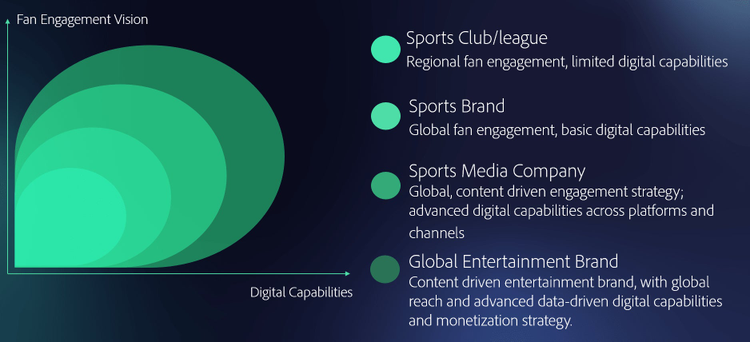Bringing The Sports Stadium To Digital
COVID-19 might be keeping sports aficionadas on their couches for the foreseeable future, but with digital on their teams, leagues can continue to engage fans.

The COVID-19 crisis has created huge changes in the way companies do business. While much of the attention has been focused on digital retailing, supply chains, and connectivity, the sports industry is also part of this dramatic wave of change.
At the timing of this writing, a few leagues, such as the Bundesliga football league in Germany, are back in play. Others, such as football league La Liga in Spain and golfing’s PGA in the United States, are set to resume action in the near future. But much remains in flux, making it clear that clubs and leagues will have to find alternative ways to keep fans engaged as stadiums remain empty.
The opportunity is huge. After months without sports, fans are ever more eager to engage with their favorite clubs and leagues. While in lockdown, Premier League’s eSports league alone secured over 150 million total video views. This increase in digital engagement is likely to continue, and leagues and teams recognize that. For example, in mid-April, the NBA announced a multiyear partnership with Microsoft to create a direct-to-consumer platform that delivers personalized fan-engagement experiences and enhanced streaming capabilities.
As more teams and leagues shift their strategies to the new reality of “fanless” stadiums—along with a growing interest in sports from new regions and audiences, developing expectations of a digital-native fan base, and increased competition over fans’ attention—a new approach is required to remaining competitive and retaining a home-field advantage outside the stadium.
Adobe’s Digital Strategy Group (DSG) has identified three ways the sports industry can digitally engage with fans to win over their attention, loyalty, and business.
Collect And Connect Data To Monetize On Fan Intelligence
According to a Nielsen survey of 18 major markets, interest in sports has increased dramatically, especially in China, India, and the United States. In addition, some teams and leagues are reaching a majority of their fan bases outside of the club’s country of origin. For example, in its latest annual report, English football club Manchester United reported that over 75% of its games’ viewers are based outside of the U.K.
While in the past few years sports clubs and leagues were opening new physical spaces, such as stadiums, the first step to digital engagement is improving their data intelligence.
Understanding different fan audiences is not easy. A lot of their digital activity takes place on third-party platforms, which typically have strong, but necessary, restrictions on what data can be extracted. Out of 20 European football clubs assessed by Adobe’s DSG, only a quarter were able to drive more than 10% of their social media audiences to their websites. Meaning, most of the fans’ data stayed with the third parties.
The ability to understand traits and behaviors of different types of fans is key to improving reach on social media, providing enhanced experiences, driving more transparent and targeted media that creates a return on investment (ROI), and reducing wasted ad spend. It can also support new sponsor partnerships by using the data to fuel more relevant partner offers to fans.
By bringing segmentation capabilities in-house and combining first-party prospect and customer data (which the teams and leagues own) with second-party data (from sponsors and partners) and third-party data subscriptions to specific data about audiences, teams and leagues can overcome challenges, such as the inability to recognize some visitors to their digital properties or to connect data about different fan segments.
Streaming viewership data should also be factored in. According to the latest “Money League” report by Deloitte, broadcast revenue remains the most prominent source of revenue for the sports industry. As leagues move to launch standalone over-the-top (OTT) services, it is clear this data is becoming essential as a means to understand fans’ preferences.
Differentiate With Content And Personalized Experiences
Sports teams and leagues also can leverage technology to better execute on experiences and engage fans more effectively. This is especially true as younger, digital-native sports fans grow in number and start making their own spending decisions.
Personalization can help. Adobe DSG identified three areas of focus when considering sophisticated personalization tactics to effectively engage with audiences across the fan journey:
• Content and product marketing: Teams and leagues need to tailor their online experiences to different types of fans. Some are doing so by using their first-party behavioral data to recommend content (e.g., articles or videos). For example, English professional football club Tottenham Hotspur changes the layout of its site based on user behaviour. In practice, content related to the women’s first team will be featured to users who engaged with that team.
More advanced teams and leagues also are using various testing and optimization tactics alongside insights from analytics to generate different types of digital experiences. Leaders are also collecting information from fans (e.g., personal information, favorite players, preferred channels of communication) to further personalize content and experiences before and after the game.
• E-commerce: Teams and leagues are using data intelligence to drive a more personalized online retail experience based on advanced tactics, such as dynamic promotions based on predictive analytics. For example, Juventus, the leading Italian football club, incorporates personalized e-commerce offers on its website by leveraging information about its members. In addition, leaders are using their sites and app data together with partners and sponsors to create special offers and email campaigns that promote specific products or services.
• Game-day experience: When fans are able to return to stadiums to watch games, teams and leagues can learn from digital leaders, such as U.K. football club Manchester United, which has used chat apps, user-generated content, interactive games and quizzes, and personalized alerts to keep their match-day platforms engaging. In the stadium prior to the coronavirus, leaders such as U.S. football team Green Bay Packers and U.S. basketball team Golden State Warriors employed geolocation capabilities to send in-app notifications with personalized offerings.
Operate And Govern As A Global Brand
To properly collect data and deliver personalized experiences that place fans—not products or channels—at the center, sports teams and leagues must adapt their organizational structures for new digital capabilities, collaboration, and agility.
Many teams and leagues have adopted a vision to become a global entertainment brand, driven by data to provide audiences across different regions with rich, personalized content and experiences. To make that transition, teams and leagues must develop a clear fan-engagement strategy and vision, while supporting growth efforts with specific digital capabilities:

Adobe’s DSG has identified various organizational structures that can help them catch up on their digital efforts to become global entertainment brands. They are centers of excellence (COEs), customer journey teams, and agile marketing teams—with the ultimate vision of integrating all three components. The COE is currently the most common organizational structure used by leagues and teams, generally comprising a concentrated team of subject matter experts who execute a specific capability and build expertise throughout the organization.
For teams and leagues with small marketing teams that are looking to reduce redundancy, align initiatives, and enable teams, COEs can be important to properly execute fan engagement strategy and introduce new digital capabilities.
Conclusion
Mandates around COVID-19 bring many challenges to sports teams and leagues—but also unique opportunities to accelerate digital transformation and reengage with fans online. It also adds an element of urgency, as digital engagement becomes, for more teams, the only type of fan engagement.
With a growing interest from untapped markets and increased competition over the attention of digital-natives, the industry must develop new ways of working to meet fans’ ever-changing behaviors and expectations. Clear vision for the fan experience, digital capabilities, and an agile organizational structure are key to helping teams and leagues deliver exceptional fan experiences and bring back to fans the magic of sports.